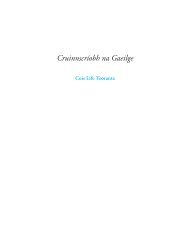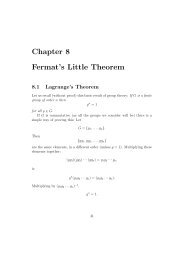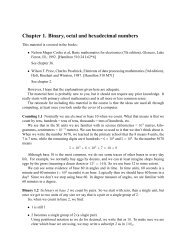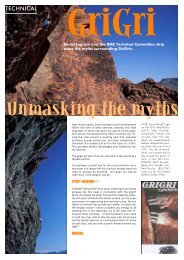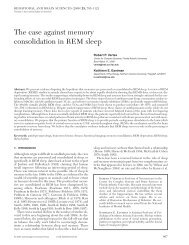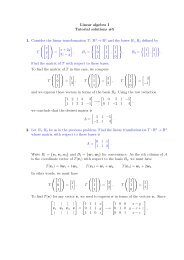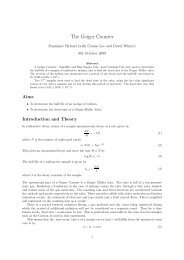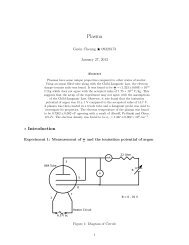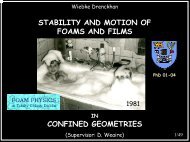ON R¨OBER'S CONSTRUCTION OF THE HEPTAGON By William ...
ON R¨OBER'S CONSTRUCTION OF THE HEPTAGON By William ...
ON R¨OBER'S CONSTRUCTION OF THE HEPTAGON By William ...
Create successful ePaper yourself
Turn your PDF publications into a flip-book with our unique Google optimized e-Paper software.
<strong>ON</strong> RÖBER’S C<strong>ON</strong>STRUCTI<strong>ON</strong> <strong>OF</strong> <strong>THE</strong><br />
HEPTAG<strong>ON</strong><br />
<strong>By</strong><br />
<strong>William</strong> Rowan Hamilton<br />
(Philosophical Magazine, 27 (1864), pp. 124–132.)<br />
Edited by David R. Wilkins<br />
2000
On Röber’s Construction of the Heptagon. <strong>By</strong> Sir <strong>William</strong> Rowan Hamilton,<br />
LL.D., M.R.I.A., F.R.A.S., &c., Andrews Professor of Astronomy in the<br />
University of Dublin, and Royal Astronomer of Ireland*.<br />
[The London, Edinburgh and Dublin Philosophical Magazine and Journal of Science,<br />
4th series, vol. xxvii (1864), pp. 124–132.]<br />
1. In a recent Number of the Philosophical Magazine, observations were made on some<br />
approximate constructions of the regular heptagon, which have recalled my attention to a<br />
very remarkable construction of that kind, invented by a deceased professor of architecture at<br />
Dresden, Friedrich Gottlob Röber†, who came to conceive, however, that it had been known<br />
to the Egyptians, and employed by them in the building of the temple at Edfu. Röber,<br />
indeed, was of opinion that the connected triangle, in which each angle of the base is triple<br />
of the angle at the vertex, bears very important relations to the plan of the human skeleton,<br />
and to other parts of nature. But without pretending to follow him in such speculations,<br />
attractive as they may be to many readers, I may be permitted to examine here the accuracy<br />
of the proposed geometrical construction, of such an isosceles triangle, or of the heptagon<br />
which depends upon it. The closeness of the approximation, although short of mathematical<br />
rigour, will be found very surprising.<br />
2. Röber’s diagram is not very complex, and may even be considered to be elegant; but<br />
the essential parts of the construction are sufficiently expressed by the following formulæ: in<br />
which p denotes a side of a regular pentagon; r, r ′ the radii of its inscribed and circumscribed<br />
circles; r ′′ the radius of a third circle, concentric with but exterior to both; p ′ a segment of<br />
the side p; and q, s, t, u, v five other derived lines. The result is, that in the right-angled<br />
triangle of which the inner diameter 2r is the hypotenuse, and u, v supplementary chords,<br />
the former chord (u) is very nearly equal to a side of a regular heptagon, inscribed in the<br />
interior circle; while the latter chord (v) makes with the diameter (2r) an angle φ, which is<br />
* Communicated by the Author.<br />
† The construction appears to have been first given in pages 15, 16 of a quarto work by his<br />
son, Friedrich Röber, published at Dresden in 1854, and entitled Beiträge zur Erforschung der<br />
geometrischen Grundformen in den alten Tempeln Aegyptens, und deren Beziehung zur alten<br />
Naturerkenntniss. It is repeated in page 20 of a posthumous work, or collection of papers,<br />
edited by the younger Röber, and published at Leipzig in 1861, entitled Elementar-Beiträge<br />
zur Bestimmung des Naturgesetzes der Gestaltung und des Widerstandes, und Anwendung<br />
dieser Beiträge auf Natur und alte Kunstgestaltung, von Friedrich Gottlob Röber, ehemaligen<br />
Königlich-Sächsischen Professor der Baukunst und Land-Baumeister. Both works, and a third<br />
upon the pyramids, to which I cannot at present refer, are replete with the most curious<br />
speculations, into which however I have above declined to enter.<br />
1
very nearly equal to the vertical angle of an isosceles triangle, whereof each angle at the base<br />
is triple of the angle at the vertex. In symbols, if we write<br />
u = 2r sin φ, v = 2r cos φ,<br />
then φ is found to be very nearly = π<br />
. It will be seen that the equations can all be easily<br />
7<br />
constructed by right lines and circles alone, having in fact been formed as the expression of<br />
such a construction; and that the numerical ratios of the lines, including the numerical values<br />
of the sine and cosine of φ, can all be arithmetrically computed*, with a few extractions of<br />
square roots.<br />
⎧<br />
(r + r<br />
⎪⎨<br />
(A)<br />
⎪⎩<br />
′ ) 2 = 5r 2<br />
r ′<br />
= 1.2360680<br />
r<br />
p 2 = 4(r ′2 − r 2 p<br />
)<br />
= 1.4530851<br />
r<br />
p ′ 1 r + 2 =<br />
p r′<br />
r + r ′<br />
p ′<br />
= 1.0514622<br />
r<br />
q 2 = p 2 − p ′2<br />
q<br />
= 1.0029374<br />
r<br />
s 2 + ps = (p − q + r) 2 s<br />
= 0.8954292<br />
r<br />
r ′′2 = r 2 + s 2<br />
r ′′<br />
= 1.3423090<br />
r<br />
t 2 � � ′ ′′ 2<br />
r r<br />
= − (r<br />
r<br />
′′ − r) 2 t<br />
= 1.6234901<br />
r<br />
u 2 u<br />
= 2r(2r − t)<br />
= 0.8677672<br />
r<br />
v 2 v<br />
= 2rt<br />
= 1.8019379<br />
r<br />
u = 2r sin φ sin φ = 0.4338836<br />
v = 2r cos φ cos φ = 0.9009689<br />
3. On the other hand, the true septisection of the circle may be made to depend on the<br />
solution of the cubic equation,<br />
8x 3 + 4x 2 − 4x − 1 = 0,<br />
of which the roots are cos 2π 4π 6π<br />
, cos , cos . Calculating then, by known methods†, to eight<br />
7 7 7<br />
decimals, the positive root of this equation, and thence deducing to seven decimals, by square<br />
* The computations have all been carried out to several decimal places beyond what are<br />
here set down. Results of analogous calculations have been given by Röber, and are found in<br />
page 16 of the first-cited publication of his son, with the assumption p = √ 3, and with one<br />
place fewer of decimals.<br />
† Among these the best by far appears to be Horner’s method,—for practically arranging<br />
2
oots, the sine and cosine of π<br />
, we find, without tables, the values<br />
7<br />
cos 2π<br />
7<br />
sin π<br />
7 =<br />
cos π<br />
7 =<br />
= x = 0.62348980;<br />
�<br />
1 − x<br />
2<br />
= 0.4338837;<br />
�<br />
1 + x<br />
= 0.9009689;<br />
2<br />
and these last agree so nearly with the values (A) of sin φ and cos φ, that at this stage a<br />
doubt may be felt, in which direction does the construction err. In fact, Röber appears to<br />
have believed that the construction described above was geometrically rigorous, and had<br />
been known and prized as such from a very remote antiquity, although preserved as a secret<br />
doctrine, entrusted only to the initiated, and recorded only in stone.<br />
4. The following is an easier way, for a reader who may not like so much arithmetic,<br />
to satisfy himself of the extreme closeness of the approximation, by formulæ adapted to<br />
logarithms, but rigorously derived from the construction. It being evident that<br />
let φ1 . . . φ6 be six auxiliary angles, such that<br />
r ′ = r sec π<br />
π<br />
, and p = 2r tan<br />
5 5 ,<br />
r ′ = 2r tan φ1, p ′ = p sin 2φ2, p − q = r tan 2 φ3,<br />
p − q + r = 1<br />
2 p tan 2φ4, s = r tan 2φ5, r(r ′′ − r) = r ′ r ′′ sin φ6;<br />
we shall then have the following system of equations, to which are annexed the angular values,<br />
deduced by interpolation from Taylor’s seven-figure logarithms, only eleven openings of which<br />
the figures in the use of which method, a very compact and convenient form or scheme was<br />
obligingly communicated to me by Professor De Morgan, some time ago. We arrived independently<br />
at the following value, to 22 decimals, of the positive root of the cubic mentioned<br />
above:<br />
cos 2π<br />
= 0 · 62348 98018 58733 53052 50.<br />
7<br />
I had however found, by trials, before using Horner’s method, the following approximate<br />
value:<br />
cos 2π<br />
= 0 · 62348 98018 587;<br />
7<br />
which was more than sufficiently exact for comparison with Röber’s construction.<br />
3
are required, if the logarithms of two and four be remembered, as they cannot fail to be by<br />
every calculator.<br />
(B)<br />
⎧<br />
cot φ1 = 2 cos π<br />
5<br />
sin 2φ2 = cos 2 φ1<br />
tan 2 φ3 = 4 sin 2 φ2 tan π<br />
⎪⎩<br />
cos 2 φ = cos φ6 sec 2φ5 tan φ1<br />
′ ′′<br />
◦<br />
φ1 = 31 43 2 · 91<br />
φ2 = 23 10 35 · 52<br />
⎪⎨<br />
φ3 = 33 51 31 · 90<br />
5<br />
cot 2φ4 = cos 2 φ3 tan π<br />
φ4 = 31 41 39 · 37<br />
5<br />
tan 2φ5 = 2 sin 2 φ4 sec 2φ4 tan π<br />
5 φ5 = 20 55 15 · 93<br />
sin φ6 = sin 2 φ5 cot φ1<br />
φ6 = 11 54 22 · 60<br />
φ = 25 42 51 · 4 .<br />
It is useless to attempt to estimate hundredths of seconds in this last value, because<br />
the difference for a second, in the last logarithmic cosine, amounts only to ten units in the<br />
seventh place of decimals, or to one in the sixth place. But if we thus confine ourselves to<br />
tenths of seconds, a simple division gives immediately that final value, under the form<br />
π<br />
7<br />
= 180◦<br />
7 = 25◦ 42 ′ 51 ′′ · 4;<br />
it appears therefore to be difficult, if it be possible, to decide by Taylor’s tables, whether<br />
the equations (B), deduced from Röber’s construction, give a value of the angle φ, which is<br />
greater or less than the seventh part of two right angles. (It may be noted that 2 tan φ1 = 2;<br />
but that to take out φ1 by this equation would require another opening of the tables.)<br />
5. To fix then decisively the direction of the error of the approximation, and to form with<br />
any exactness an estimate of its amount, or even to prove quite satisfactorily by calculation<br />
that any such error exists, it becomes necessary to fall back on arithmetic; and to carry<br />
at least the first extractions to several more places of decimals,—although fewer than those<br />
which have been used in the resumed computation might have sufficed, except for the extreme<br />
accuracy aimed at in the resulting values. For this purpose, it has been thought convenient<br />
to introduce eight auxiliary numbers a . . . h, which can all be calculated by square roots, and<br />
are defined with reference to the recent equations (B), as follows:<br />
a = 1 + 2 tan φ1; b = 4 cos 2φ2 cot π<br />
5 ; c = 2 cos 2φ2 − cot π<br />
5 ;<br />
d = sec 2φ4; e = sec 2φ5; f = 2 cos 2 φ; g = 2 cos φ; h = 2 cos φ<br />
2 ;<br />
or thus with reference to the earlier equations (A):<br />
a =<br />
r + r′<br />
r<br />
; b = 8qr<br />
p<br />
2(q − r)<br />
; c = ; d = 2 p<br />
4<br />
2s + p<br />
; e =<br />
p<br />
r′′<br />
r ;
f = t<br />
;<br />
r<br />
v<br />
f =<br />
r ; h2 2r + v<br />
= ;<br />
r<br />
and respecting which it is to be observed that c, like the rest, is positive, because it may be<br />
put under the form<br />
�<br />
14 − 2<br />
c =<br />
√ �<br />
5 5 + 2<br />
−<br />
5<br />
√ 5<br />
,<br />
5<br />
and 14 − 2 √ 5 > 5 + 2 √ 5, because 9 > 4 √ 5, or 9 2 > 4 2 5. With these definitions, then, of the<br />
numbers a . . . h, and with the help of the following among other identities,<br />
cos 7φ<br />
2<br />
sec φ<br />
2<br />
= 2 cos 3φ − 2 cos 2φ + 2 cos φ − 1<br />
= 2(2 cos φ − 1) cos 2φ − 1,<br />
I form without tables a system of values below, the early numbers of which have been computed<br />
to several decimals more than are set down.<br />
⎧<br />
a<br />
⎪⎨<br />
(C)<br />
2 = 5<br />
b<br />
a = 2 · 23606 79774 99789 6964<br />
2 = 8 + 72a<br />
25<br />
c<br />
b = 3 · 79998 36545 96345 0138<br />
2 = 19<br />
− b<br />
5<br />
d<br />
c = 0 · 00404 29449 23565 7641<br />
2 = 1 + (2 − c) 2<br />
d = 2 · 23245 25898 01044 7849<br />
e 2 = 1 + (5 − 2a)(d − 1) 2<br />
e = 1 · 34230 90137 74792 5831<br />
f 2 = (5 − 2a)e 2 + 2e − 1 f = 1 · 62349 00759 24105 2470<br />
g 2 = 2f g = 1 · 80193 78878 99638 5912<br />
h<br />
⎪⎩<br />
2 = 2 + g h = 1 · 94985 58633 65197 2049<br />
�<br />
π − 7φ<br />
sin = h (f − 1)(g − 1) −<br />
2<br />
1<br />
�<br />
= +0 · 00000 06134 49929 1683.<br />
2<br />
Admitting then the known value,<br />
or the deduced expression,<br />
I infer as follows:<br />
(D)<br />
1 ′′ =<br />
⎪⎩<br />
π = 3 · 14159 26535 89793 . . . ,<br />
π<br />
648000<br />
= 0 · 00000 48481 36811 095 . . . ,<br />
⎧<br />
π − 7φ<br />
⎪⎨<br />
= +0<br />
2<br />
′′ · 12653 31307 822,<br />
π<br />
7 − φ = +0′′ · 03615 23230 806,<br />
φ = 25 ◦ 42 ′ 51 ′′ · 39241 91054 91,<br />
and think that these twelve decimals of a second, in the value of the angle φ, may all be relied<br />
on, from the care which has been taken in the calculations.<br />
5
6. The following is a quite different way, as regards the few last steps, of deducing the<br />
same ultimate numerical results. Admitting (comp. Art. 3) the value*,<br />
2 cos 2π<br />
7<br />
= z = 1 · 24697 96037 17467 06105,<br />
as the positive root, computed by Horner’s method, of the cubic equation<br />
z 3 + z 2 − 2z − 1 = 0,<br />
and employing the lately calculated value f of 1 + cos 2φ, I find by square roots the following<br />
sines and cosines, with the same resulting error of the angle φ as before:<br />
(E)<br />
⎧<br />
sin<br />
⎪⎨<br />
⎪⎩<br />
π 1√<br />
= 2 − z = 0 · 43388 37391 17558 1205;<br />
7 2<br />
cos π 1√<br />
= 2 + z = 0 · 90096 88679 02419 1262;<br />
7 2<br />
sin φ = 1�<br />
4 − 2f = 0 · 43388 35812 03469 1138;<br />
2<br />
cos φ = 1�<br />
1<br />
2f = g = 0 · 90096 89439 49819 2956;<br />
2<br />
�<br />
2<br />
π<br />
�<br />
sin − φ = +0 · 00000 01752 71408 3339;<br />
7<br />
π<br />
7 − φ = +0′′ · 03615 23230 806.<br />
7. If we continue the construction, as Röber did, so as to form an isosceles triangle, say<br />
ABC, with φ for its vertical angle, and if we content ourselves with thousandths of seconds,<br />
the angles of this triangle will be as follows:<br />
(F)<br />
⎧<br />
⎪⎨<br />
B =<br />
⎪⎩<br />
A = φ = 25 ◦ 42 ′ 51 ′′ · 392;<br />
π − φ<br />
2 = 77◦ 8 ′ 34 ′′ · 304;<br />
C = B = 77 ◦ 8 ′ 34 ′′ · 304;<br />
and we see that each base-angle exceeds the triple of the vertical by only about an eighth part<br />
of a second, namely by that small angle which occurs first in the system (D), and of which the<br />
sine is the last number in the preceding system (C). And if we compare a base-angle of the<br />
triangle thus constructed, with the base-angle 3π<br />
7 = 77◦ 8 ′ 34 ′′ · 2857 . . . of the true triangle,<br />
in which each angle of the base is triple of the angle at the vertex, we find an error in excess<br />
equal nearly to 0 ′′ · 018, or, more exactly,<br />
* Compare a preceding note.<br />
B − 3π<br />
7 = +0′′ · 01807 61615 403,<br />
6
which amounts to less than a fifth-fifth part of a second, but of which I conceive that all the<br />
thirteen decimals here assigned are correct. And I suppose that no artist would undertake to<br />
construct a triangle which should more perfectly, or so perfectly, fulfil the conditions proposed.<br />
The problem, therefore, of constructing such a triangle, and with it the regular heptagon, by<br />
right lines and circles only, has been practically solved by that process which Röber believed<br />
to have been known to the ancient Egyptians, and to have been employed by them in the<br />
architecture of some of their temples—some hints, as he judged, being intentionally preserved<br />
in the details of the workmanship, for the purpose of being recognized, by the initiated of the<br />
time, or by men of a later age.<br />
8. Another way of rendering conceivable the extreme smallness of the practical error of<br />
that process, is to imagine a series of seven successive chords inscribed in a circle, according<br />
to the construction in question, and to inquire how near to the initial point the final point<br />
would be. The answer is, that the last point would fall behind the first, but only by about<br />
half a second (more exactly by 0 ′′ ·506). If then we suppose, for illustration, that these chords<br />
are sevven successive tunnels, drawn eastward from station to station of the equator of the<br />
earth, the last tunnel would emerge to the west of the first station, but only by about fifty<br />
feet.<br />
9. My own studies have not been such as to entitle me to express an opinion whether<br />
the architectural and geometrical drawings of Röber in connexion with the plan of the temple<br />
at Edfu, and his comparisons of the numbers deduced from the details of his construction<br />
with French measurements previously made, are sufficient to bear out his conclusion, that<br />
the process had been anciently used: but I wish that some qualified person would take up<br />
the inquiry, which appears to me one of great interest, especially as I see no antecedent<br />
improbability in the supposition that the construction in question may have been invented in<br />
a very distant age. The geometry which it employs is in no degree more difficult than that of<br />
the Fourth Book of Euclid*; and although I have no conjecture to offer as to what may have<br />
suggested the particular process employed, yet it seems to me quite as likely to have been<br />
discovered thousands of years ago, perhaps after centuries of tentation, as to have been first<br />
found in our own time, which does not generally attact so much importance to the heptagon<br />
as a former age may have done, and which perhaps enjoys no special facilities in the search<br />
after such a construction, although it supplies means of proving, as above, that the proposed<br />
solution of the problem is not mathematically perfect.<br />
10. If Röber’s professional skill as an architect, combined with the circumstance stated<br />
of his having previously invented the construction for himself did really lead him to a correct<br />
to the<br />
r<br />
three radii, which enter into the equations (A), and of which the latter is the greater segment<br />
of the third diameter, 2r ′′ , if this last be cut in extreme and mean ratio, may at first appear<br />
to depend on the Sixth Book of Euclid, but will be found to be easily constructible without<br />
going beyond the Fourth Book.<br />
* The segment p ′ of the side p of the pentagon, and the fourth proportional r′ r ′′<br />
7
interpretation* of the plan of the temple at Edfu, which he believed to embody a tradition<br />
much older than itself, we are thus admitted to a very curious glimpse, or even a partial<br />
view, of the nature and extent, but at the same time the imperfection, of that knowledge of<br />
geometry which was possessed, but kept secret, by the ancient priests of Egypt. I say the<br />
imperfection, on the supposition that the above described construction of the heptagon, if<br />
known to them at all, was thought by them to be equal in rigour, as the elder Röber appears<br />
to have thought it to be, to that construction of the pentagon which Euclid may have learned<br />
from them, rejecting perhaps, at the same time, the other construction, as being not based<br />
on demonstration, and not by him demonstrable, although Euclid may not have known it to<br />
be, in its result, imperfect. The interest of the speculation stretches indeed back to a still<br />
earlier age, and may be connected in imagination with what we read of the “wisdom of the<br />
Egyptians.” But I trust that I shall be found to have abstained, as I was bound to do, from<br />
any expression which could imply an acquaintance of my own with the archæology of Egypt,<br />
and that I may at least be pardoned, if not thanked, for having thus submitted, to those who<br />
may be disposed to study the subject, a purely mathematical† discussion, although connected<br />
with a question of other than mathematical interest.<br />
Observatory of Trinity College, Dublin,<br />
December 22, 1863.<br />
W. R. H.<br />
* It ought in fairness to be stated that Röber’s interpretation of Egyptian antiquities<br />
included a vast deal more than what is here described, and that he probably considered the<br />
geometrical part of it to be the least interesting, although still, in his view, an essential and<br />
primary element.<br />
† Note added during printing.—Some friends of the writer may be glad to know that these<br />
long arithmetical calculations have been to him rather a relaxation than a distraction from his<br />
more habitual studies, and that there are already in type 672 octavo pages of the ‘Elements<br />
of Quaternions,’ a work which (as he hopes) is rapidly approaching to the stage at which it<br />
may be announced for publication.<br />
8



